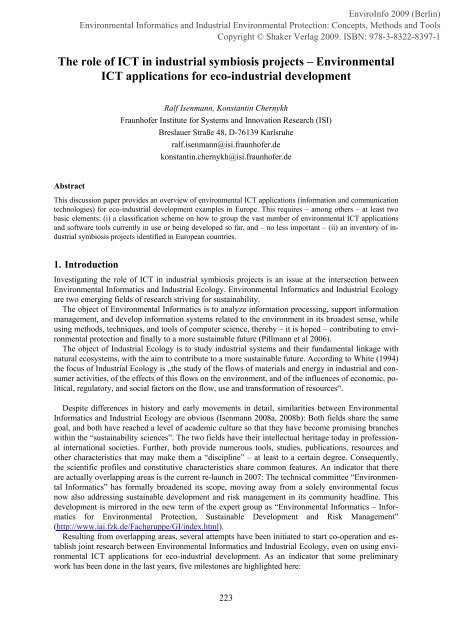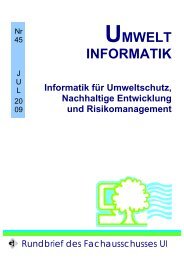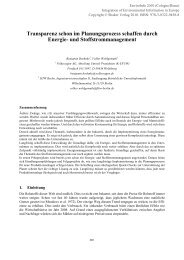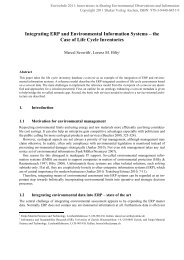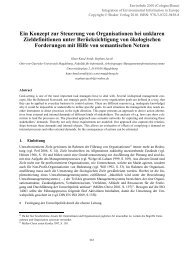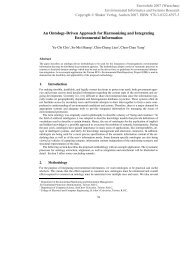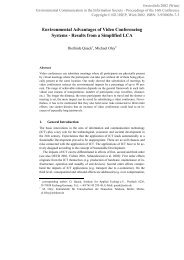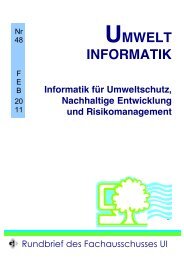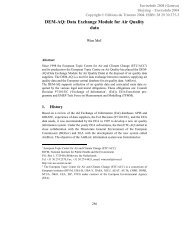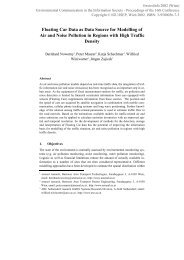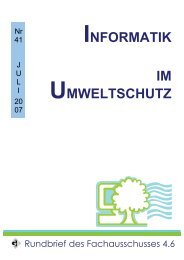Environmental ICT applications for eco-industrial ... - EnviroInfo
Environmental ICT applications for eco-industrial ... - EnviroInfo
Environmental ICT applications for eco-industrial ... - EnviroInfo
Create successful ePaper yourself
Turn your PDF publications into a flip-book with our unique Google optimized e-Paper software.
<strong>EnviroInfo</strong> 2009 (Berlin)<br />
<strong>Environmental</strong> In<strong>for</strong>matics and Industrial <strong>Environmental</strong> Protection: Concepts, Methods and Tools<br />
Copyright © Shaker Verlag 2009. ISBN: 978-3-8322-8397-1<br />
The role of <strong>ICT</strong> in <strong>industrial</strong> symbiosis projects – <strong>Environmental</strong><br />
<strong>ICT</strong> <strong>applications</strong> <strong>for</strong> <strong>eco</strong>-<strong>industrial</strong> development<br />
Ralf Isenmann, Konstantin Chernykh<br />
Fraunhofer Institute <strong>for</strong> Systems and Innovation Research (ISI)<br />
Breslauer Straße 48, D-76139 Karlsruhe<br />
ralf.isenmann@isi.fraunhofer.de<br />
konstantin.chernykh@isi.fraunhofer.de<br />
Abstract<br />
This discussion paper provides an overview of environmental <strong>ICT</strong> <strong>applications</strong> (in<strong>for</strong>mation and communication<br />
technologies) <strong>for</strong> <strong>eco</strong>-<strong>industrial</strong> development examples in Europe. This requires – among others – at least two<br />
basic elements: (i) a classification scheme on how to group the vast number of environmental <strong>ICT</strong> <strong>applications</strong><br />
and software tools currently in use or being developed so far, and – no less important – (ii) an inventory of <strong>industrial</strong><br />
symbiosis projects identified in European countries.<br />
1. Introduction<br />
Investigating the role of <strong>ICT</strong> in <strong>industrial</strong> symbiosis projects is an issue at the intersection between<br />
<strong>Environmental</strong> In<strong>for</strong>matics and Industrial Ecology. <strong>Environmental</strong> In<strong>for</strong>matics and Industrial Ecology<br />
are two emerging fields of research striving <strong>for</strong> sustainability.<br />
The object of <strong>Environmental</strong> In<strong>for</strong>matics is to analyze in<strong>for</strong>mation processing, support in<strong>for</strong>mation<br />
management, and develop in<strong>for</strong>mation systems related to the environment in its broadest sense, while<br />
using methods, techniques, and tools of computer science, thereby – it is hoped – contributing to environmental<br />
protection and finally to a more sustainable future (Pillmann et al 2006).<br />
The object of Industrial Ecology is to study <strong>industrial</strong> systems and their fundamental linkage with<br />
natural <strong>eco</strong>systems, with the aim to contribute to a more sustainable future. According to White (1994)<br />
the focus of Industrial Ecology is „the study of the flows of materials and energy in <strong>industrial</strong> and consumer<br />
activities, of the effects of this flows on the environment, and of the influences of <strong>eco</strong>nomic, political,<br />
regulatory, and social factors on the flow, use and trans<strong>for</strong>mation of resources“.<br />
Despite differences in history and early movements in detail, similarities between <strong>Environmental</strong><br />
In<strong>for</strong>matics and Industrial Ecology are obvious (Isenmann 2008a, 2008b): Both fields share the same<br />
goal, and both have reached a level of academic culture so that they have b<strong>eco</strong>me promising branches<br />
within the “sustainability sciences”. The two fields have their intellectual heritage today in professional<br />
international societies. Further, both provide numerous tools, studies, publications, resources and<br />
other characteristics that may make them a “discipline” – at least to a certain degree. Consequently,<br />
the scientific profiles and constitutive characteristics share common features. An indicator that there<br />
are actually overlapping areas is the current re-launch in 2007: The technical committee “<strong>Environmental</strong><br />
In<strong>for</strong>matics” has <strong>for</strong>mally broadened its scope, moving away from a solely environmental focus<br />
now also addressing sustainable development and risk management in its community headline. This<br />
development is mirrored in the new term of the expert group as “<strong>Environmental</strong> In<strong>for</strong>matics – In<strong>for</strong>matics<br />
<strong>for</strong> <strong>Environmental</strong> Protection, Sustainable Development and Risk Management”<br />
(http://www.iai.fzk.de/Fachgruppe/GI/index.html).<br />
Resulting from overlapping areas, several attempts have been initiated to start co-operation and establish<br />
joint research between <strong>Environmental</strong> In<strong>for</strong>matics and Industrial Ecology, even on using environmental<br />
<strong>ICT</strong> <strong>applications</strong> <strong>for</strong> <strong>eco</strong>-<strong>industrial</strong> development. As an indicator that some preliminary<br />
work has been done in the last years, five milestones are highlighted here:<br />
223
• The Journal of Industrial Ecology (JIE) published a special issue on: “Electronic commerce,<br />
the internet and the environment” in 2002. This special edition was an early attempt<br />
to pull together, and critically examine, the research on <strong>ICT</strong> and the environment.<br />
The focus was primarily on data, analysis, and reasoned interpretation<br />
(http://www3.interscience.wiley.com/journal/120133161/issue).<br />
• The 22 nd International Conference on In<strong>for</strong>matics <strong>for</strong> <strong>Environmental</strong> Protection, <strong>EnviroInfo</strong><br />
2008 in Lüneburg (Germany), was explicitly announced under the converging<br />
banner: “<strong>Environmental</strong> In<strong>for</strong>matics and Industrial Ecology”<br />
(http://www.enviroinfo2008.org/). This banner implies connections, linkages, and<br />
common characteristics between <strong>Environmental</strong> In<strong>for</strong>matics and Industrial Ecology.<br />
<strong>Environmental</strong> <strong>ICT</strong> <strong>applications</strong> like data processing techniques, simulation tools, environmental<br />
accounting systems, geographical in<strong>for</strong>mation systems (GIS), visualization<br />
modules, environmental management in<strong>for</strong>mation systems (EMIS), and reporting wizards<br />
are enablers and could be considered as facilitators <strong>for</strong> various Industrial Ecology<br />
<strong>applications</strong> like environmental monitoring and life cycle assessment, material flow<br />
analysis, environmental risk management, environmental management accounting &<br />
reporting.<br />
• The JIE (www.yale.edu/jie/cfp-ict.html) currently invites submissions <strong>for</strong> a special issue<br />
on: “<strong>Environmental</strong> <strong>applications</strong> of in<strong>for</strong>mation and communications technology<br />
(<strong>ICT</strong>)”. The call <strong>for</strong> papers is open to autumn 2009 (deadline: September 15 th ). The aim<br />
of this s<strong>eco</strong>nd special issue explicitly focused on the intersection of <strong>Environmental</strong> In<strong>for</strong>matics<br />
and Industrial Ecology is to describe innovations in <strong>ICT</strong> used <strong>for</strong> central concerns<br />
and methods of Industrial Ecology.<br />
• The International Society <strong>for</strong> Industrial Ecology (ISIE) has launched a new section on<br />
<strong>eco</strong>-<strong>industrial</strong> development (EIDC, http://www.is4ie.org/sections). This new section is<br />
particularly devoted to <strong>industrial</strong> symbiosis projects, bringing together academics and<br />
practitioners with a passion <strong>for</strong> translating concepts of Industrial Ecology theory into<br />
practice. The news was announced at the 5 th International Conference on Industrial<br />
Ecology, 2009 Lisbon (Portugal): “Transitions Towards Sustainability”.<br />
• The latest ef<strong>for</strong>t is an expert workshop: “The role of <strong>ICT</strong> in <strong>industrial</strong> symbiosis<br />
projects” (http://www.enviroinfo2009.org), embedded in the 23 rd International Conference<br />
on In<strong>for</strong>matics <strong>for</strong> <strong>Environmental</strong> Protection, <strong>EnviroInfo</strong> 2009 in Berlin (Germany).<br />
As a part of the FP7 EU project “<strong>ICT</strong>-ENSURE, http://www.ict-ensure.eu/), the<br />
objective of the expert workshop is to investigate the role of <strong>ICT</strong> in <strong>industrial</strong> symbiosis<br />
projects, and describe significant synergies that could be exploited by using innovations<br />
in <strong>ICT</strong> <strong>for</strong> <strong>industrial</strong> symbiosis projects.<br />
The milestones above could be taken as a sign <strong>for</strong> three developments: first, in both communities<br />
the issue of environmental <strong>ICT</strong> <strong>applications</strong> <strong>for</strong> <strong>eco</strong>-<strong>industrial</strong> development is regarded as of increasing<br />
relevance; s<strong>eco</strong>nd, the issue provides an excellent example that <strong>Environmental</strong> In<strong>for</strong>matics and Industrial<br />
Ecology share common features, and hence both communities may foster co-operation and<br />
joint research; third, while Industrial Ecology has its early focus in the 1980s in an engineering/technological-<br />
and resource/industry-focused bipolar view (Ayres and Ayres 1996), largely concentrated<br />
on physical phenomena, today the community has broadened its scope to the immaterial<br />
world of bits & bytes, data, in<strong>for</strong>mation, knowledge and the critical intersection with computational<br />
sciences.<br />
2. Classification scheme <strong>for</strong> environmental <strong>ICT</strong> <strong>applications</strong><br />
Currently, a vast number of environmental <strong>ICT</strong> <strong>applications</strong> is in use or under development. To obtain<br />
order in the great variety, a classification scheme is presented that helps to classify environmental <strong>ICT</strong><br />
<strong>applications</strong>. This classification scheme consists of five different approaches:<br />
• methods- and technologies-driven approach (2.1),<br />
224<br />
Copyright © Shaker Verlag 2009. ISBN: 978-3-8322-8397-1
• approach related to in<strong>for</strong>mation processing (2.2),<br />
• environmental management-focused approach (2.3),<br />
• approach based on empirical studies (2.4), and<br />
• impact-driven approach in terms of sustainability (2.5).<br />
These five approaches highlighted here are regarded as prototypical <strong>for</strong> the <strong>Environmental</strong> In<strong>for</strong>matics<br />
literature and community, at least to a certain degree.<br />
2.1 Methods- and technologies-driven approach<br />
The methods- and technologies-driven approach identifies on which core methods environmental<br />
<strong>ICT</strong> <strong>applications</strong> are primarily based on and which key technologies these <strong>applications</strong> are actually using.<br />
For example, environmental <strong>ICT</strong> <strong>applications</strong> used to detect and visualize potential physical exchanges<br />
in an urban planning context have probably their roots in geographic in<strong>for</strong>mation systems<br />
(GIS) (Fernandez and Ruiz; Massard and Erkman in this volume). A wizard <strong>for</strong> sustainability reporting<br />
in <strong>eco</strong>-<strong>industrial</strong> parks is likely based on internet technologies and the use of XML (Isenmann et<br />
al. 2007; Isenmann and Marx Gómez 2008).<br />
The criterion of the methods- and technologies-driven approach highlights so-called core methods<br />
and key technologies that could be seen as exemplary <strong>for</strong> the <strong>Environmental</strong> In<strong>for</strong>matics literature, so<br />
far. Based on empirical evidence, Page and Hilty (1995, 21) and later on Rautenstrauch and Patig<br />
(2001, ii) presented a pool of eleven methods and technologies that makes the <strong>Environmental</strong> In<strong>for</strong>matics<br />
tool set:<br />
• data analysis,<br />
• computer graphics and visualisation,<br />
• remote sensing,<br />
• geographic in<strong>for</strong>mation systems (GIS),<br />
• environmental database systems,<br />
• current markup languages like XML (extensible markup language),<br />
• modelling and simulation,<br />
• knowledge- and expert-based systems, neuronal networks and artificial intelligence,<br />
• software ergonomics and user interfaces,<br />
• world wide web and internet technologies and services, and<br />
• ERP systems (enterprise resource planning).<br />
This approach related to methods and technologies may provide a proper categorization of environmental<br />
<strong>ICT</strong> <strong>applications</strong> <strong>for</strong> a certain time period. As methods and technologies depend heavily on<br />
the progression made in computer science as well as on latest trends in hardware and software, it b<strong>eco</strong>mes<br />
clear that the tool set changes over time. It has a dynamic nature. Despite emerging innovations<br />
in <strong>ICT</strong> − e.g. web services and semantic technologies − the tool set above probably gives an impression<br />
what in the <strong>Environmental</strong> In<strong>for</strong>matics community is regarded as the basis in terms of methods<br />
and technologies.<br />
2.2 Approach related to in<strong>for</strong>mation processing<br />
The criterion that makes this approach particular is the different nature of in<strong>for</strong>mation and – as a result<br />
–the certain type in<strong>for</strong>mation is processed. Following this approach, five different environmental<br />
<strong>ICT</strong> <strong>applications</strong> can be distinguished (Page and Rautenstrauch 2001, 3):<br />
• Monitoring and control systems are processing data gathered through continuous measurements<br />
in water, air, soil, noise, and radiation control. Monitoring and control systems<br />
are often equipped with data analysis techniques, e.g. to aggregate time series data, classify<br />
environmental objects, or identify hazardous substances. These systems usually need<br />
to process vague in<strong>for</strong>mation and handle with data defects.<br />
225<br />
Copyright © Shaker Verlag 2009. ISBN: 978-3-8322-8397-1
• Conventional in<strong>for</strong>mation systems include basic features like input, storage, structuring,<br />
integration, retrieval, and presentation of environmental data. These data are usually available<br />
in various <strong>for</strong>ms and <strong>for</strong>mats, e.g. as raw measurement data, description of environmental<br />
objects, and structured text in documents. As standard database technology is limited<br />
in dealing with spatial and temporal queries, relational data base systems may need<br />
certain extensions to process environmental data properly.<br />
• Computational analysis systems provide sophisticated mathematical-statistical analysis<br />
methods and modelling techniques. These systems enable environmental data processing<br />
in a more detailed and in depth manner. Core functions include the aggregation and visualization<br />
of environmental data, provision of conclusions based on structures found in environmental<br />
data, as well as statistical evaluation and data mining. Modelling and simulation<br />
techniques are applied <strong>for</strong> <strong>for</strong>ecasting, model calculations, and scenario-analyses.<br />
• Decision support systems (DSS) assist all phases and aspects of decision making, be it<br />
group and participatory decision making processes. DSS are used at corporate or any<br />
higher level across single entities like in municipalities <strong>for</strong> urban planning or local waste<br />
management. DSS help in particular to evaluate different possibilities and justify why and<br />
how certain decisions have been made, e.g. <strong>for</strong> environmental impact analyses, handling<br />
hazardous substances, water resource management, and technical risk assessment.<br />
• Integrated environmental in<strong>for</strong>mation systems take into account that pure types of environmental<br />
<strong>ICT</strong> <strong>applications</strong> focusing one issue like legal compliance or material input and<br />
energy consumption merely provide limited managerial support. Hence current environmental<br />
<strong>ICT</strong> <strong>applications</strong> available today are more and more designed as distributed systems<br />
enabling the integration of certain modules later on, like data base systems, GIS, and<br />
simulation or visualization systems.<br />
An approach related to in<strong>for</strong>mation processing seems to be useful when defining specific requirements<br />
that environmental <strong>ICT</strong> <strong>applications</strong> need to fulfil. These requirements are influencing which<br />
in<strong>for</strong>mation is actually needed and how a certain type of in<strong>for</strong>mation is then processed. For example,<br />
dealing with spatial and temporal environmental data as it is typical <strong>for</strong> long-term measurements in<br />
water, air, and soil control requires tailored environmental <strong>ICT</strong> <strong>applications</strong> to be found in monitoring<br />
and control systems. If − in turn − the central purpose is to support environmental management systems<br />
(EMS), then companies may implement an integrated environmental management in<strong>for</strong>mation<br />
systems (EMIS), with certain specialised modules, e.g. <strong>for</strong> analyses, planning, implementation, controlling,<br />
reporting and communication.<br />
2.3 <strong>Environmental</strong> management-focused approach<br />
The approach focused on environmental management indicates the degree environmental <strong>ICT</strong> <strong>applications</strong><br />
are supporting environmental management systems (EMS). Probably the most known and<br />
famous examples of EMS are the world-wide standard ISO 14000 series (ISO 2008) and the European<br />
Union’s Eco-Management and Audit Scheme (EMAS) (EC 2008). These EMS are applicable <strong>for</strong><br />
companies and other organizations to evaluate, report and improve their environmental per<strong>for</strong>mance.<br />
Organizations run EMS to improve their environmental per<strong>for</strong>mance on a continuous basis. In particular,<br />
EMAS-registered organizations are legally compliant, and evaluate and report on their environmental<br />
per<strong>for</strong>mance through the publication of an independently verified environmental statement.<br />
These publications are r<strong>eco</strong>gnised by the EMAS logo which guarantees the reliability of the in<strong>for</strong>mation<br />
provided (EC 2001).<br />
<strong>Environmental</strong> <strong>ICT</strong> <strong>applications</strong> implemented as a part of their EMS are called <strong>Environmental</strong><br />
Management In<strong>for</strong>mation Systems (EMIS). Embedded in a certain organizational context, EMIS are<br />
socio-technological systems. They are used as business <strong>applications</strong> with the aim to gather, process,<br />
and provide environmental data, inside organizations and in exchange with other actors in industry or<br />
local administration. EMS prototypically fulfil a number of tasks and include various processes, i.e.:<br />
analysis, planning, implementation and controlling, and check (Hilty and Rautenstrauch 1995). These<br />
226<br />
Copyright © Shaker Verlag 2009. ISBN: 978-3-8322-8397-1
tasks and processes make the heart of EMS. Any task and process in EMS again correspond to certain<br />
functions that EMIS may support. Hence, environmental <strong>ICT</strong> <strong>applications</strong> can be grouped according to<br />
EMS support, e.g. <strong>for</strong> gathering, processing, and providing environmental data, be it inside or in exchange<br />
with external stakeholders.<br />
• Legal compliance and other external requirements are driving <strong>for</strong>ces pushing companies<br />
to do more than just smart “green-washing”. First, EMIS help to comply with laws<br />
and regulations. They provide insights into complex legal frameworks, e.g. on in<strong>for</strong>mation<br />
retrieval networks <strong>for</strong> environmental regulations. Further, they assist decision makers<br />
in discovering business activities that are of relevance <strong>for</strong> environmental regulations,<br />
e.g. by emission monitoring.<br />
• S<strong>eco</strong>nd, EMIS provide mechanisms to get feedback from external stakeholders and to<br />
capture requirements from a larger audience, not just from business partners. Such<br />
feedback loops are usually installed in the <strong>for</strong>m of stakeholder relations management<br />
systems.<br />
• Next, EMIS support material flow management, including material flow modelling and<br />
evaluation. For example, EMIS provide help when identifying material and energy inputs,<br />
collecting relevant data, and preparing <strong>eco</strong>-balances. Based upon insights drawn<br />
from an <strong>eco</strong>-balance, EMIS further assist impact assessments and balance valuations in<br />
order to assess environmental impacts due to material and energy flows. Once material<br />
flows are modelled and evaluated, EMIS help to improve <strong>eco</strong>-efficiency. The measures<br />
that could be taken range from product life cycles and production processes to whole<br />
companies. Elaborated methods offer support, e.g. Life Cycle Analysis (LCA) and Design<br />
<strong>for</strong> the Environment (DFE), just to mention a few.<br />
• When the measures <strong>for</strong> improvement in EMS have been implemented and controlled<br />
according to <strong>eco</strong>-efficiency, then all activities and results need to be documented in reports<br />
and communicated. Here EMIS provide an array of benefits to improve communication<br />
and reporting both, <strong>for</strong> companies and their stakeholders (Isenmann 2008d). For<br />
example, EMIS can overcome the restrictions of freestanding documents with limited<br />
contents, print media fixation, disclosure in a one size fits all fashion, and one-waycommunication.<br />
Together, the basic tasks and operational processes in EMS and corresponding EMIS functions are<br />
building a closed loop procedure, finally leading to a process model of continuous environmental improvements.<br />
Ideally, the different EMIS functions are combined to a coherent system and fully integrated<br />
into an organization’s <strong>ICT</strong> infrastructure, while supporting all tasks throughout an EMS (Rautenstrauch<br />
1999).<br />
Just recently, Teuteberg and Straßenburg (2009) provided an overview of the state of the art and future<br />
research in EMIS. Based on a comprehensive analysis and review of literature in <strong>Environmental</strong><br />
In<strong>for</strong>matics dated from 2000 and 2008, they found five clusters in EMIS-related articles:<br />
• EMIS in general, e.g. development & implementation, integration in ERP systems,<br />
• sustainability reporting, e.g. technical issues, automation,<br />
• material flow, e.g. development & implementation, simulation, data defects,<br />
• waste management, and<br />
• environmental in<strong>for</strong>mation management.<br />
The analysis to EMIS-related research shed light on current foci in <strong>Environmental</strong> In<strong>for</strong>matics. Despite<br />
progression companies have made in running EMIS in recent years and though concepts of enterprise<br />
application integration (EAI) have been proposed, however, EMIS are usually not incorporated<br />
elements, today (Isenmann and Rautenstrauch 2007). Particularly they are no standard element of<br />
ERP systems which are common <strong>for</strong> business in<strong>for</strong>mation systems; − this is also true <strong>for</strong> management<br />
accounting systems. Such integration has just partly taken place. For example, in my SAP® PLM<br />
(Product Lifecycle Management), there is a module on Environment, Health and Safety (EH&S). Its<br />
227<br />
Copyright © Shaker Verlag 2009. ISBN: 978-3-8322-8397-1
focus though is rather limited to the documentation of waste management following national laws <strong>for</strong><br />
handling hazardous substances (SAP 2005).<br />
2.4 Approach based on empirical studies<br />
The three classifications mentioned above take a deductive perspective, more or less. The approach<br />
based on empirical studies follows an inductive principle. In terms of empirical studies, pretty less had<br />
been done, yet. An exception is the analysis Grant (2007) has conducted. He analyzed case studies<br />
publicly available in the Industrial Ecology literature with the aim to assess the current progress of environmental<br />
<strong>ICT</strong> <strong>applications</strong> in supporting <strong>industrial</strong> symbiosis projects.<br />
In total, Grant (2007, 22-23) identified 16 environmental <strong>ICT</strong> <strong>applications</strong> built to facilitate <strong>industrial</strong><br />
symbiosis projects (tab. 1). Of the sixteen environmental <strong>ICT</strong> <strong>applications</strong> identified, one software<br />
tool is available <strong>for</strong> purchase on the internet; two are in use though they are not publicly available; <strong>for</strong><br />
nine there is no publicly available evidence whether they are still in use.<br />
Of the 12 environmental <strong>ICT</strong> <strong>applications</strong> identified, seven were developed in USA, three in<br />
Europe, and two elsewhere. Interestingly, the three operational <strong>applications</strong> were developed in Europe.<br />
Of course, these numbers merely provide a first impression of how environmental <strong>ICT</strong> <strong>applications</strong> are<br />
being developed and where they are being used.<br />
Based on his review over the past ten years, Grant (2007, 40) considered usability, training and expertise<br />
and high start-up costs as common critical challenges. He particularly found that environmental<br />
<strong>ICT</strong> <strong>applications</strong> he examined have strengths in technical opportunities when identifying potential<br />
physical exchanges. The <strong>applications</strong> identified, however, show much room <strong>for</strong> improvements in<br />
building relationships between people, enabling communication and facilitating co-operation.<br />
2.5 Impact-driven approach in terms of sustainability<br />
The impact-driven approach focuses on the effects <strong>ICT</strong> – and hence environmental <strong>ICT</strong> <strong>applications</strong><br />
– are causing in terms of sustainability (Hilty 2008). The point is that environmental <strong>ICT</strong> <strong>applications</strong><br />
surely provide an array of benefits and increase efficiencies on the one hand (Hilty et al. 2005); on the<br />
other hand, however, they also imply consequences, e.g. in terms of scarce resources, energy consumption,<br />
and electronic waste, just to mention a few (Geibler et al. 2005).<br />
228<br />
Copyright © Shaker Verlag 2009. ISBN: 978-3-8322-8397-1
No. <strong>Environmental</strong> <strong>ICT</strong> application &<br />
country of development<br />
1 Knowledge-based decision support-systems<br />
New Zeeland and Canada<br />
2 Designing <strong>industrial</strong> <strong>eco</strong>systems toolkit<br />
USA<br />
3 Industrial Materials Exchange Tool<br />
USA<br />
4 Dynamic Industrial Materials Exchange Tool<br />
USA<br />
5 MatchMaker!<br />
USA<br />
6 Industrial Ecology Planning Tool<br />
USA<br />
7 WasteX<br />
Commonwealth Caribbean, Jamaica, Australia<br />
8 Industrial Ecosystem Development Project<br />
USA<br />
9 Residual Utilization Expert System<br />
USA<br />
10 Institute of Eco-Industrial Analysis Waste Manager<br />
Germany<br />
11 Industrie et Synergies Inter-Sectorielles and Presteo<br />
France<br />
12 Core Resource <strong>for</strong> Industrial Symbiosis Practitioners<br />
UK<br />
Country<br />
&<br />
geographical scale<br />
Trinidad<br />
Industrial park<br />
Burlington Vermont,<br />
USA<br />
Industrial park<br />
City of Brownsville,<br />
USA; Tampico, Mexico<br />
City<br />
Greater Yellowstone-<br />
Teton region, USA<br />
Region<br />
USA, Vietnam, United<br />
Arab Emirates, Saudi<br />
Arabia<br />
City<br />
USA<br />
Industrial Park<br />
Jamaica<br />
Nation<br />
USA<br />
Region<br />
USA<br />
City & State<br />
Germany<br />
Region<br />
France, Switzerland<br />
Region<br />
UK<br />
Nation<br />
Status<br />
Completed<br />
Cancelled<br />
Cancelled<br />
Completed<br />
Completed<br />
Completed<br />
Completed<br />
Cancelled<br />
Availability<br />
None<br />
Public, reportably unusable,<br />
requires MS<br />
Office 95<br />
None<br />
None<br />
None<br />
Source code available,<br />
requires ArcView GIS<br />
None<br />
None<br />
Completed Available to the original<br />
project funding<br />
organizations, requires<br />
level 5 software shell<br />
Operational Reporting software;<br />
purchase and demo<br />
available over the web<br />
– analysis and optimization<br />
systems under<br />
development<br />
Operational In use by the developer<br />
Operational Restricted to NISP<br />
participants and practitioners<br />
Table 1: <strong>Environmental</strong> <strong>ICT</strong> <strong>applications</strong> <strong>for</strong> <strong>industrial</strong> symbiosis projects (Grant 2007, 22-23)<br />
In order to describe the complex relationships between <strong>ICT</strong> and sustainability, the working group<br />
“Nachhaltige In<strong>for</strong>mationsgesellschaft“ (Sustainable In<strong>for</strong>mation Society) of the German Society <strong>for</strong><br />
In<strong>for</strong>matics proposed a two-dimensional grid (Dompke et al. 2004; Isenmann 2008c). This grid comprises<br />
fundamental criteria <strong>for</strong> sustainability set against three different levels of impacts of <strong>ICT</strong>. Three<br />
dimensions describe the fundamental sustainability criteria:<br />
• Human compatibility: Individuals should not suffer damages from development. Their<br />
personal dignity must be respected.<br />
• Social compatibility: Relationships of people with one another and the resulting society<br />
should not be infringed. Individual participation in our communities needs to be protected<br />
and supported.<br />
• Ecological compatibility: The natural environment must not be irreversibly damaged, and<br />
our life support systems must be protected.<br />
229<br />
Copyright © Shaker Verlag 2009. ISBN: 978-3-8322-8397-1
The impacts of <strong>ICT</strong> on individuals, society, and nature are classified according to three different<br />
perspectives:<br />
• Effects of <strong>ICT</strong> provision, e.g. use of resources and energy in manufacturing, use and disposal<br />
of <strong>ICT</strong> hardware.<br />
• Effects of <strong>ICT</strong> use, e.g. energy savings from process optimisation or commuter traffic reduction<br />
as a result of tel<strong>eco</strong>mmunication.<br />
• Systemic effects, e.g. rebound effects as a reaction to efficiency gains, changes of <strong>eco</strong>nomic<br />
structures, institutions and consequences <strong>for</strong> individual lifestyles.<br />
The combination of sustainability criteria and levels of <strong>ICT</strong> impacts results in a 3x3 matrix. For all<br />
nine fields, status quo and practical r<strong>eco</strong>mmendations towards a more sustainable in<strong>for</strong>mation society<br />
are described. For example, r<strong>eco</strong>mmendations <strong>for</strong> <strong>ICT</strong> provision cover measures to create and maintain<br />
an <strong>ICT</strong> infrastructure in a more sustainable manner. Apart from direct effects of provision and use,<br />
<strong>ICT</strong> lead to a number of rebound effects which must be neutralised so that achieved efficiency gains<br />
and possible resource savings are not offset by other, wasteful ways of using <strong>ICT</strong> (<strong>eco</strong>logical compatibility).<br />
The impact-driven approach is a reminder that the development of environmental <strong>ICT</strong> <strong>applications</strong><br />
<strong>for</strong> <strong>industrial</strong> symbiosis projects is not merely a technical issue <strong>for</strong> computer scientists within <strong>Environmental</strong><br />
In<strong>for</strong>matics. It is also an issue <strong>for</strong> users involved in <strong>eco</strong>-<strong>industrial</strong> developments, and hence<br />
it is a matter of Industrial Ecology, particularly in terms of environmental impact assessment.<br />
3. Inventory of <strong>industrial</strong> symbiosis projects in Europe<br />
The basic idea underlying <strong>industrial</strong> symbiosis projects is that <strong>eco</strong>nomic entities share in<strong>for</strong>mation,<br />
services, utilities, and by-product resources among one or more <strong>industrial</strong> actors with the aim to add<br />
value, reduce costs, and improve environmental per<strong>for</strong>mance (Côté and Cohen-Rosenthal 1998; Chertow<br />
2007). Typically, these projects have a particular focus on material and energy exchange, while<br />
<strong>eco</strong>nomic entities are often from separate industries. They are brought together in a collective approach.<br />
The characteristics are collaboration and synergistic possibilities offered by geographic proximity.<br />
Economic entities involved in <strong>industrial</strong> symbiosis projects may collectively optimize material<br />
and energy use across single entities. Consequently, considering efficiencies goes beyond those<br />
achievable by any individual process alone. It is ideally more like behaviour of a local community.<br />
Due to the promising approach, <strong>industrial</strong> symbiosis projects have been initiated worldwide (critical:<br />
Gibbs and Deutz 2005, 2007). Various examples could be found in Europe (e.g. Eilering and<br />
Vermeulen 2004; Liwarska-Bizukojc et al. 2009), USA & Canada (e.g. Chertow 2007; Gibbs and<br />
Deutz 2007), Asia (e.g. Chiu and Yong 2004; Park et al. 2008), and Australia (e.g. Roberts 2004; van<br />
Berkel 2006;). Though is seems useful to having a full r<strong>eco</strong>rd of <strong>industrial</strong> symbiosis projects available,<br />
a central inventory is missing, yet. No comprehensive catalogue exists that is online or publicly<br />
available, not even offered by the ISIE.<br />
An inventory − preferably accessible online − would be a valuable source to better analyze <strong>industrial</strong><br />
symbiosis projects, e.g. to identify success factors and detect obstacles. Particularly an inventory<br />
would also be fruitful to investigate the role of <strong>ICT</strong> in <strong>industrial</strong> symbiosis projects. The following table<br />
may be a starting point <strong>for</strong> such enterprise. The collection includes a total of more than 70 examples,<br />
located in 12 European countries. The collection is just a snapshot. It is not based on a systematic<br />
research method. The examples identified have been extracted from the current Industrial Ecology literature<br />
and a survey in the internet.<br />
230<br />
Copyright © Shaker Verlag 2009. ISBN: 978-3-8322-8397-1
Example:<br />
Name & City<br />
Hartberg Öko<br />
Park, Hartberg<br />
Industrial Symbiosis,<br />
Kalundborg<br />
Ecopark<br />
Oulu<br />
Oulu,<br />
Ecosite du Pays<br />
de Thau, Meze,<br />
Montpellier<br />
Zero<br />
Park<br />
Emission<br />
Optimisation of<br />
Resource Use<br />
and Waste<br />
Management,<br />
Langhe area<br />
Sunflower Farm<br />
Ecological<br />
Technology<br />
Centres<br />
Agro Industrial<br />
Complex Dinteloord,<br />
Dinteloord<br />
Instituto Technologico<br />
y de<br />
Energias Renovables,<br />
Tenerife<br />
Landskrona Industrial<br />
Symbiosis<br />
Project,<br />
Landskrona<br />
Industrial Symbiosis<br />
Project in<br />
Geneva, Geneva<br />
National Industrial<br />
Symbiosis<br />
Programme,<br />
Birmingham<br />
Description & Number of <strong>industrial</strong> symbiosis projects identified in the certain country<br />
Austria (2)<br />
Public-sector led project to redevelop an <strong>industrial</strong> estate dedicated to firms pursuing environmental goals<br />
and developing/researching environmental technologies, particularly renewable energy.<br />
http://www.oekopark.at/flash6.htm<br />
Denmark (3)<br />
A highly evolved and self-organising network of manufacturing firms and local partners involved in the<br />
by-product exchange of waste materials, water, and energy. http://www.symbiosis.dk/; Start: 1959<br />
Finland (4)<br />
A business park to promote environmental improvement of products and services through innovation and<br />
R&D on one site. The Ecopark is part of a wider regional strategy to develop an environment cluster in the<br />
area. http://nortech.oulu.fi/eng/palvelut.html<br />
France (4)<br />
A municipal authority-led project established to promote local sustainable development, pollution abatement<br />
and tourism. Start: 1985<br />
Germany (16)<br />
A research project funded by the Federal Ministry of Transport, Building and Urban Affairs and the Federal<br />
Office <strong>for</strong> Building and Regional Planning, including four <strong>industrial</strong> parks with more than 600 entities.<br />
http://www.zeroemissionpark.de, Start: 2008-2009<br />
Italy (4)<br />
A project carried out with the Politecnico di Torino and a consortium of small and medium enterprises<br />
(SMEs) on a planned <strong>eco</strong>-<strong>industrial</strong> park. Start: 2001-2004<br />
Netherlands (14)<br />
The complex under development is intended to strengthen the <strong>eco</strong>nomic position through lower production<br />
costs on the one hand, and to generate environmental and spatial gains on the other. Start: 1996<br />
Poland (1)<br />
Five initiatives currently under development. The first is planned <strong>for</strong> Stryszow, near Cracow and will act<br />
as a demonstration site <strong>for</strong> environmental technologies based around water, energy, and waste.<br />
Spain (1)<br />
A local authority-led research and demonstration centre established in 1991. Based around renewable<br />
energy and environmental technology, the site also includes a visitor centre. Start: 1991<br />
Sweden (3)<br />
An <strong>industrial</strong> symbiosis project in Landskrona, Sweden, initiated in 2002 by the International Institute <strong>for</strong><br />
Industrial Environment Economics (IIIEE), Lund. Start: 2002<br />
Swiss (1)<br />
Project focused on territorial and <strong>industrial</strong> planning with the aim to go beyond recycling systems by locally<br />
reusing material and energy flows through by-product exchange networks. Start: 2006<br />
UK (20)<br />
NISP is an innovative business opportunity programme that delivers bottom line benefits <strong>for</strong> members<br />
whilst generating positive outcomes <strong>for</strong> the environment and society. http://www.nisp.org.uk/, Start: 2006<br />
Table 2: Industrial symbiosis projects in Europe, selected examples<br />
231<br />
Copyright © Shaker Verlag 2009. ISBN: 978-3-8322-8397-1
4. Conclusion and outlook<br />
The aim of this discussion paper was to provide an overview of environmental <strong>ICT</strong> <strong>applications</strong> <strong>for</strong><br />
<strong>eco</strong>-<strong>industrial</strong> development examples in Europe. There<strong>for</strong>e, a classification scheme was presented that<br />
helps to obtain order in the vast number of <strong>ICT</strong> <strong>applications</strong> and software tools. Five different approaches<br />
prototypical <strong>for</strong> <strong>Environmental</strong> In<strong>for</strong>matics were highlighted: (i) methods- and technologiesdriven<br />
approach, (ii) approach related to in<strong>for</strong>mation processing, (iii) environmental managementfocused<br />
approach, (iv) approach based on empirical studies and (v) impact-driven approach in terms of<br />
sustainability. A comprehensive classification including all five approaches would result in a multidimensional<br />
grid. This grid may help to analyze which environmental <strong>ICT</strong> <strong>applications</strong> are in use or under<br />
development when to advance <strong>eco</strong>-<strong>industrial</strong> development. As a starting point <strong>for</strong> an inventory of<br />
<strong>industrial</strong> symbiosis projects in European countries, more than 70 examples were identified through an<br />
exploratory analysis.<br />
As a larger goal, the paper is an attempt to bring together the <strong>ICT</strong>-driven field of <strong>Environmental</strong> In<strong>for</strong>matics<br />
on the one hand and the environmental-focused area of Industrial Ecology on the other hand.<br />
Although the two fields share a number of common features, institutional co-operation and joint research<br />
could be improved, still. Progression in environmental <strong>ICT</strong> <strong>applications</strong> enable an array of<br />
unique capabilities to be employed <strong>for</strong> <strong>industrial</strong> symbiosis projects, especially <strong>for</strong> the management of<br />
physically exchanging materials, energy, water, and by-products and – no less important – <strong>for</strong> the<br />
management of relationships. Further to a mere one-sided transfer from <strong>Environmental</strong> In<strong>for</strong>matics to<br />
Industrial Ecology, <strong>Environmental</strong> In<strong>for</strong>matics may benefit from Industrial Ecology: For example, the<br />
certain requirements and specific needs of actors involved in <strong>industrial</strong> symbiosis projects may deliver<br />
fruitful ideas <strong>for</strong> the <strong>Environmental</strong> In<strong>for</strong>matics community as the types of <strong>eco</strong>-<strong>industrial</strong> development<br />
follow a more systemic view, across single entities. Software engineers might be interested on how to<br />
further develop isolated environmental <strong>ICT</strong> <strong>applications</strong> like standalone EMIS in single companies to<br />
an integral <strong>ICT</strong> infrastructure, enabling inter-organisational exchange of environmental data, finally to<br />
the benefit of all decision makers involved in long-term <strong>eco</strong>-developments, be they managers, suppliers,<br />
consumers, local authorities, non-governmental institutions, or other organizations affected by<br />
such projects based on collaboration, synergistic possibilities, and geographic proximity.<br />
Acknowledgements<br />
Thanks to Martin Arntz and Matthias Mruzek <strong>for</strong> their support on that research project. All errors and<br />
omissions remain the responsibility of the authors. The paper here is based on two presentations, initially<br />
held at the 22 nd International Conference on In<strong>for</strong>matics <strong>for</strong> <strong>Environmental</strong> Protection (<strong>EnviroInfo</strong><br />
2008; http://www.enviroinfo2008.org): <strong>Environmental</strong> In<strong>for</strong>matics and Industrial Ecology, 10 th<br />
-12 th September 2008, Leuphana University of Lüneburg (Germany), and later in a refined and updated<br />
fashion at the 5 th International Conference on Industrial Ecology (2009 ISIE Conference;<br />
http://isie2009.com): Transitions Towards Sustainability, 21 st -24 th June 2009, Lisboa (Portugal).<br />
References<br />
Ayres, R.U.; Ayres, L.W. (1996): Industrial <strong>eco</strong>logy. Towards closing the material cycle. Cheltenham,<br />
Brookfield : Edward Elgar.<br />
Chertow, M. (2007): “Uncovering” Industrial Symbiosis. Journal of Industrial Ecology 11(1): 11-30.<br />
Chiu, A.S.F.; Yong, G. (2004): On the <strong>industrial</strong> <strong>eco</strong>logy potential in Asian developing countries.<br />
Journal of Cleaner Production 12, 1037-1045.<br />
Côté, R.P.; Cohen-Rosenthal, E. (1998): Designing <strong>eco</strong>-<strong>industrial</strong> parks: a synthesis of some experiences.<br />
Journal of Cleaner Production 6: 181-188.<br />
Dompke, M.; Geibler, J. von; Göhring, W.; Herget, M.; Hilty, L.M.; Isenmann, R.; Kuhndt, M.; Naumann,<br />
S.,; Quack, D.; Seifert, E.K. (Eds.) (2004): Memorandum Nachhaltige In<strong>for</strong>mationsgesellschaft.<br />
Stuttgart: Fraunhofer IRB. Online available: ,<br />
access 2005-01-24.<br />
232<br />
Copyright © Shaker Verlag 2009. ISBN: 978-3-8322-8397-1
Eilering, J.A.M.; Vermeulen, W.J.V. (2004): Eco-<strong>industrial</strong> parks: Towards <strong>industrial</strong> symbiosis and<br />
utility sharing in practice. Progress of Industrial Ecology 1(1/2/3): 245-270.<br />
European Commission (2008): EMAS The Eco-Management and Audit Scheme. Online available:<br />
, access 2008-02-19.<br />
European Communities (2001): Regulation (EC) No. 761/2001 of the European Parliament and of the<br />
Council of 19 March 2001 allowing voluntary participation by organisations in a Community<br />
<strong>eco</strong>-management and audit scheme (EMAS). Official Journal of the European Communities, L<br />
114<br />
Geibler J. von; Kuhndt M.; Türk, V. (2005). Virtual networking without a backpack? Resource consumption<br />
of in<strong>for</strong>mation technologies. In<strong>for</strong>mation systems <strong>for</strong> sustainable development. Hilty,<br />
L.M.; Seifert E.K.; Treibert, R. (Eds.). Hershey: Idea Publishing, 109-126.<br />
Gibbs, D.; Deutz, P. (2005): Implementing <strong>industrial</strong> <strong>eco</strong>logy? Planning <strong>for</strong> <strong>eco</strong>-<strong>industrial</strong> parks in the<br />
USA. Geo<strong>for</strong>um 36: 452-464.<br />
Gibbs, D.; Deutz, P. (2007): Reflections on implementing <strong>industrial</strong> <strong>eco</strong>logy through <strong>eco</strong>-<strong>industrial</strong><br />
park development. Journal of Cleaner Production 15: 1683-1695.<br />
Grant, G.B. (2007): Knowledge infrastructure <strong>for</strong> <strong>industrial</strong> symbiosis: Progress in in<strong>for</strong>mation and<br />
communication technology. Yale University. Industrial <strong>Environmental</strong> Management Center <strong>for</strong><br />
Industrial Ecology.<br />
Hilty, L.M. (2008): In<strong>for</strong>mation technology and sustainability. Essays on the relationship between in<strong>for</strong>mation<br />
technology and sustainable development. Norderstedt: Book on Demand.<br />
Hilty, L.M.; Rautenstrauch, C. (1995): Betriebliche Umweltin<strong>for</strong>matik. Umweltin<strong>for</strong>matik. In<strong>for</strong>matikmethoden<br />
für Umweltschutz und Umwelt<strong>for</strong>schung. B. Page; L.M. Hilty (Eds). München,<br />
Wien: 2 nd ed. Oldenbourg, 295-312.<br />
Hilty, L.M.; Seifert, E.K.; Treibert, R. (Eds.) (2005): In<strong>for</strong>mation systems <strong>for</strong> sustainable development.<br />
Hershey: Idea Publishing.<br />
International Organization <strong>for</strong> Standardization (ISO): ISO 14000 essentials. Online available:<br />
, access 2008-02-19.<br />
Isenmann, R. (2008a): <strong>Environmental</strong> in<strong>for</strong>matics and <strong>industrial</strong> <strong>eco</strong>logy – scientific profiles of two<br />
emerging fields striving <strong>for</strong> sustainability. <strong>Environmental</strong> in<strong>for</strong>matics and <strong>industrial</strong> <strong>eco</strong>logy. A.<br />
Möller; B. Page; M. Schreiber (Eds.). Aachen: Shaker 2008, 14-22.<br />
Isenmann, R. (2008b): Setting the boundaries and highlighting the scientific profile of <strong>industrial</strong> <strong>eco</strong>logy.<br />
In<strong>for</strong>mation technologies in environmental engineering, Special Issue January 1(1): 32-39,<br />
online available: .<br />
Isenmann, R. (2008c): Sustainable in<strong>for</strong>mation society. Encyclopedia of in<strong>for</strong>mation ethics and security.<br />
M. Quigley (Ed.). Hershey: IGI Global, 622-630.<br />
Isenmann, R. (2008d): <strong>Environmental</strong> management in<strong>for</strong>mation systems – Illustrations from online<br />
communication and sustainability reporting. Proceedings of the iEMSs fourth biennal meeting.<br />
International congress on environmental modelling and software (iEMSs 2008). M. Sánchez-<br />
Marrè; J. Béjar; J. Comas; A.E. Rizzoli; G. Guariso (Eds.). International <strong>Environmental</strong> Modelling<br />
and Software Society, Barcelona, Catalonia, July 2008, Vol. 3: 1636-1644.<br />
Isenmann, R., Rautenstrauch, C. (2007): Horizontale und vertikale Integration Betrieblicher Umweltin<strong>for</strong>mationssysteme<br />
(BUIS) in Betriebswirtschaftliche Anwendungsszenarien. Umweltwirtschafts<strong>for</strong>um<br />
15(2), 75-81.<br />
Isenmann, R.; Bey, C.; Welter, M. (2007): Online reporting <strong>for</strong> sustainability issues. Business Strategy<br />
and the Environment 16(7): 487-501.<br />
Isenmann, R.; Marx Gómez, J. (Hrsg.) (2008): Internetbasierte Nachhaltigkeitsberichterstattung. Maßgeschneiderte<br />
Stakeholder-Kommunikation mit IT. Berlin: 1 st ed. Erich Schmidt.<br />
Liwarska-Bizukojc, E.; Bizukojc, M.; Marcinkowski, A.; Doniec, A. (2009): The conceptual model of<br />
an <strong>eco</strong>-<strong>industrial</strong> park based upon <strong>eco</strong>logical relationships. Journal of Cleaner Production 17<br />
(2009) 732-741.<br />
Page, B.; Hilty, L.M. (1995): Umweltin<strong>for</strong>matik als Teilgebiet der Angewandten In<strong>for</strong>matik. Umweltin<strong>for</strong>matik.<br />
In<strong>for</strong>matikmethoden für Umweltschutz und Umwelt<strong>for</strong>schung. B. Page, L.M. Hilty<br />
(Eds.). München, Wien: 2 nd ed. Oldenbourg, 15-31.<br />
233<br />
Copyright © Shaker Verlag 2009. ISBN: 978-3-8322-8397-1
Page, B.; Rautenstrauch, C. (2001): <strong>Environmental</strong> in<strong>for</strong>matics – methods, tools and <strong>applications</strong> in<br />
environmental in<strong>for</strong>mation processing. <strong>Environmental</strong> in<strong>for</strong>mation systems in industry and administration.<br />
Rautenstrauch, C.; Patig, S. (Eds.). Hershey: Idea Group Publishing, 2-11.<br />
Park, H.-S.; Rene, E.R.; Choi, S.-M.; Chiu, A.S.F. (2008): Strategies <strong>for</strong> sustainable development of<br />
<strong>industrial</strong> park in Ulsan, South Korea − From spontaneous evolution to systematic expansion of<br />
<strong>industrial</strong> symbiosis. Journal of <strong>Environmental</strong> Management 87 (2008) 1-13.<br />
Pillmann, W.; Geiger, W.; Voigt, K. (2006): Survey of environmental in<strong>for</strong>matics in Europe. <strong>Environmental</strong><br />
Modeling & Software 21(11): 1519-1527.<br />
Rautenstrauch, C. (1999): Betriebliche Umweltin<strong>for</strong>mationssysteme. Berlin et al.: Springer.<br />
Rautenstrauch, C.; Patig, S. (Eds.) (2001): Preface. <strong>Environmental</strong> in<strong>for</strong>mation systems in industry and<br />
administration. Rautenstrauch, C.; Patig, S. (Eds.). Hershey: Idea Group Publishing, i-ii.<br />
Roberts, B.H. (2004): The application of <strong>industrial</strong> <strong>eco</strong>logy principles and planning guidelines <strong>for</strong> the<br />
development of <strong>eco</strong>-<strong>industrial</strong> parks: An Australian case study. Journal of Cleaner Production<br />
12: 997-1010.<br />
Teuteberg, F.; Straßenburg, J. (2009): State of the art and future research in environmental management<br />
in<strong>for</strong>mation systems – a systematic literature review. In<strong>for</strong>mation technologies in environmental<br />
engineering (ITEE 2009). Marx Gómez, J.; Rizzoli, A.E.; Mitkas, P.A.; Athanasiadis,<br />
I.N. (Eds.). Berlin: Springer, 64-77.<br />
van Berkel, R. (2006): Regional resource synergies <strong>for</strong> sustainable development in heavy <strong>industrial</strong><br />
areas: An overview of opportunities and experiences. Perth (WA): Australia, Curtin University<br />
of Technology. Online available<br />
<br />
White, R. (1994): Preface. The Greening of <strong>industrial</strong> <strong>eco</strong>systems. B.R. Allenby; D.J. Richards (Eds).<br />
Washington: National Academy Press.<br />
234<br />
Copyright © Shaker Verlag 2009. ISBN: 978-3-8322-8397-1


